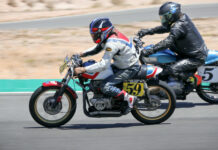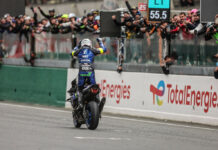Racer Santiago Villa remains hospitalized in the Burn Center at Orlando Regional Medical Center, recovering from second and third-degree burns suffered in a fuel spill and fire during a refueling pit stop at Daytona International Speedway October 19. Villa was sitting on his bike with the engine running when the male probe on his team’s quick-fill can stuck open during a pit stop in the ASRA Team Challenge, which was scheduled for 43 laps (151 miles) around the Daytona International Speedway traditional long course. Villa was drenched in race gas, which penetrated the ventilation holes in the chest of his leathers and the stretch panels in the inner thighs of his leathers, then ignited. Villa suffered second and third-degree burns on his chest and third-degree burns on his thighs. He underwent two sessions of skin graft surgery last week, with healthy unburned skin from his back and legs transplanted onto the seriously burned areas of his legs. Villa may or may not require further skin grafts onto his chest, with a decision scheduled this week. Villa expects to be hospitalized for at least another two weeks before he can go home to Colombia. Following Villa’s injury, MOTO-ST officials abandoned their policy of allowing racebikes to be refuelled with the rider on board and with the engine running, and instituted new rules requiring all refueling to be done with the rider off the bike, the engine dead and the bike securely on a rear-wheel stand. The new rules were announced at a MOTO-ST riders’ meeting held the afternoon of October 19 and were put into place for the 8-Hours of Daytona race, held October 20. Roadracing World Action Fund President John Ulrich–who has consistently argued in favor of dead-engine, rider-off pit stops in the past–suggested the rule change at the meeting and has also asked CCS/ASRA and AMA Pro Racing officials to require that the rider be off the bike, with a dead engine and with the bike on the rear stand, for all future races involving pit stops. The FIM Endurance World Championship and the WERA/AMA National Endurance Series both require rider-off, dead-engine refueling stops. AFM and CMRA endurance events also require rider-off, dead-engine refueling stops. “This is so painful, this is ridiculous,” said Villa when reached by cell phone Tuesday, his voice weak. “I was on fire from head to toe. When it was burning my face I knew it was going to be bad. And the pain. I had never felt such pain in my life. I was in a lot of pain and I am in a lot of pain. It is a miracle that I am still here.” Cards and letters can be sent to Villa at this address: Patient Santiago Villa Venegas Orlando Regional Medical Center 1414 Kuhl Ave Orlando, FL 32806 Phone (407) 841-5111 www.orhs.org
Racer Santiago Villa, Injured In Daytona Refueling Incident, Still Hospitalized In Orlando Burn Center
Racer Santiago Villa, Injured In Daytona Refueling Incident, Still Hospitalized In Orlando Burn Center
© 2007, Roadracing World Publishing, Inc. By Michael Gougis.





